Study of the Impact of Surface Topography on Selected Mechanical Properties of Adhesive Joints
Abstract
1. Introduction
2. Programme of Experimental Studies
- Vv—void volume per unit area for a given material fraction (mm3/mm2);
- Vvv—volume of valley voids located at a given surface level (mm3/mm2);
- Vvc—volume of the core void space (mm3/mm2).
- Svk—reduced valley depth, a measure of the valley depth below the core roughness (µm);
- Sci—surface core fluid retention index representing the ability of the core to retain fluid through the inequality core (no unit);
- Svi—surface valley fluid retention index representing the ability of valleys located below the core to retain fluid (no unit).
2.1. Specimen Preparation and Surface Texture Measurements
- For sample B, both faces were examined;
- For the other specimens, only one selected face of specimens A or C was examined, assuming that they were similar.
2.2. Testing the Strength of the Adhesive Joints
3. Discussion and Conclusions
Author Contributions
Funding
Institutional Review Board Statement
Informed Consent Statement
Data Availability Statement
Conflicts of Interest
References
- Grzejda, R. Modelling Nonlinear Multi-Bolted Connections: A Case of Operational Condition. In Proceedings of the 15th International Scientific Conference ‘Engineering for Rural Development 2016’, Jelgava, Latvia, 25–27 May 2016; pp. 336–341. [Google Scholar]
- Grzejda, R. New method of modelling nonlinear multi-bolted systems. In Advances in Mechanics: Theoretical, Computational and Interdisciplinary Issues, 1st ed.; Kleiber, M., Burczyński, T., Wilde, K., Gorski, J., Winkelmann, K., Smakosz, Ł., Eds.; CRC Press: Leiden, The Netherlands, 2016; pp. 213–216. [Google Scholar]
- Jaszak, P.; Skrzypacz, J.; Borawski, A.; Grzejda, R. Methodology of leakage prediction in gasketed flange joints at pipeline deformations. Materials 2022, 15, 4354. [Google Scholar] [CrossRef] [PubMed]
- Semjon, J.; Jánoš, R.; Sukop, M.; Tuleja, P.; Marcinko, P.; Nowakowski, M. Verification of a newly developed mobile robot’s actuator parameters. Machines 2023, 11, 411. [Google Scholar] [CrossRef]
- Zmarzły, P. Influence of the Internal Clearance of Ball Bearings on the Vibration Level. In Proceedings of the 24th International Conference ‘Engineering Mechanics 2018’, Svratka, Czech Republic, 14–17 May 2018; pp. 961–964. [Google Scholar]
- Zmarzły, P. Influence of bearing raceway surface topography on the level of generated vibration as an example of operational heredity. Indian J. Eng. Mater. Sci. 2020, 27, 356–364. [Google Scholar]
- Mucha, W.; Kuś, W.; Viana, J.C.; Nunes, J.P. Operational load monitoring of a composite panel using artificial neural networks. Sensors 2020, 20, 2534. [Google Scholar] [CrossRef]
- Mucha, W. Comparison of machine learning algorithms for structure state prediction in operational load monitoring. Sensors 2020, 20, 7087. [Google Scholar] [CrossRef] [PubMed]
- LOCTITE 401, Technical Data Sheet. Available online: https://datasheets.tdx.henkel.com/LOCTITE-401-pl_PL.pdf (accessed on 2 July 2024).
- 3M Scotch-Weld Flexible Acrylic Adhesive DP8610NS, Technical Data Sheet. Available online: https://multimedia.3m.com/mws/media/2365850O/3m-scotch-weld-flexible-acrylic-adhesive-dp8610ns.pdf?&fn=3M-Scotch-Weld-Flexible-Acrylic-Adhesive-DP8610NS_R3.pdf (accessed on 2 July 2024).
- 63857—UHU All Purpose Adhesive Twist & Glue, Technical Data Sheet. Available online: https://www.uhu.com/getmedia/8a611b5a-8a1b-468e-9896-86b9a8a45be2/Print%20PDF.pdf (accessed on 2 July 2024).
- Rudawska, A. Effect of a type of epoxy adhesive on the selected mechanical properties of adhesive joints of the steel sheets. Assem. Tech. Technol. 2020, 109, 47–52. [Google Scholar]
- Safari, A.; Farahani, M.; Ghabezi, P. Experimental study on the influences of different surface treatment processes and adhesive type on the aluminum adhesive-bonded joint strength. Mech. Based Des. Struct. Mach. 2022, 50, 2400–2413. [Google Scholar] [CrossRef]
- Farhang, M.; Farahani, M.; Nazari, M.; Sam-Daliri, O. Experimental correlation between microstructure, residual stresses and mechanical properties of friction stir welded 2024-T6 aluminum alloys. Int. J. Adv. Des. Manuf. Technol. 2022, 15, 1–9. [Google Scholar]
- Liu, J.; Xue, Y.; Dong, X.; Fan, Y.; Hao, H.; Wang, X. Review of the surface treatment process for the adhesive matrix of composite materials. Int. J. Adhes. Adhes. 2023, 126, 103446. [Google Scholar] [CrossRef]
- Nasresfahani, M.R.; Asghari, S. Review of nondestructive methods for evaluating adhesive bonding on anodized coatings. Int. J. Adhes. Adhes. 2023, 127, 103491. [Google Scholar] [CrossRef]
- Xie, M.; Zhan, L.; Ma, B.; Hui, S. Classification of fiber metal laminates (FMLs), adhesion theories and methods for improving interfacial adhesion: A review. Thin-Walled Struct. 2024, 198, 111744. [Google Scholar] [CrossRef]
- Hay, K.M.; Dragila, M.I.; Liburdy, J. Theoretical model for the wetting of a rough surface. J. Colloid Interface Sci. 2008, 325, 472–477. [Google Scholar] [CrossRef] [PubMed]
- Serro, A.P.; Colaço, R.; Saramago, B. Adhesion forces in liquid media: Effect of surface topography and wettability. J. Colloid Interface Sci. 2008, 325, 573–579. [Google Scholar] [CrossRef] [PubMed]
- da Silva, L.F.M.; Carbas, R.J.C.; Critchlow, G.W.; Figueiredo, M.A.V.; Brown, K. Effect of material, geometry, surface treatment and environment on the shear strength of single lap joints. Int. J. Adhes. Adhes. 2009, 29, 621–632. [Google Scholar] [CrossRef]
- Rudawska, A. Surface Preparation for Bonding Selected Construction Materials; Lublin University of Technology: Lublin, Poland, 2017. (In Polish) [Google Scholar]
- Yuan, Y.; Zhu, X.; Chen, L. Relationship among cohesion, adhesion, and bond strength: From multi-scale investigation of asphalt-based composites subjected to laboratory-simulated aging. Mater. Des. 2020, 185, 108272. [Google Scholar] [CrossRef]
- Romanik, G.; Jaszak, P.; Grzejda, R.; Zmarzły, P. Minimisation of friction resistance of elastomeric lip seals on rotating shafts. Lubricants 2024, 12, 103. [Google Scholar] [CrossRef]
- Kubit, A.; Macek, W.; Zielecki, W.; Szawara, P.; Myśliwiec, P. Experimental study of the impact of notches and holes made in the front edge of adherends on the properties of static and fatigue strength of adhesive joints. Int. J. Adhes. Adhes. 2024, 129, 103596. [Google Scholar] [CrossRef]
- Wei, Y.; Jin, X.; Luo, Q.; Li, Q.; Sun, G. Adhesively bonded joints—A review on design, manufacturing, experiments, modeling and challenges. Compos. Part B Eng. 2024, 276, 111225. [Google Scholar] [CrossRef]
- Piekarczyk, M. Application of glued connections in metal structures. Tech. Trans. Civ. Eng. 2012, 109, 99–137. [Google Scholar]
- PN-EN ISO 4287; Geometrical Product Specifications (GPS), Surface Texture: Profile method, Terms, Definitions and Surface Texture Parameters. Polish Committee for Standardization: Warsaw, Poland, 1999.
- PN-EN ISO 4288; Geometrical Product Specifications (GPS), Surface Texture: Profile method, Rules and Procedures for the Assessment of Surface Texture. Polish Committee for Standardization: Warsaw, Poland, 2011.
- PN-EN ISO 25178-2; Geometrical Product Specifications (GPS), Surface Texture: Areal, Part 2: Terms, Definitions and Surface Texture Parameters. Polish Committee for Standardization: Warsaw, Poland, 2022.
- Grochała, D.; Grzejda, R.; Parus, A.; Berczyński, S. The wavelet transform for feature extraction and surface roughness evaluation after micromachining. Coatings 2024, 14, 210. [Google Scholar] [CrossRef]
- Rudawska, A.; Dębski, H. Experimental and numerical analysis of adhesively bonded aluminium alloy sheets joints. Eksploat. Niezawodn. Maint. Reliab. 2011, 49, 4–10. [Google Scholar]
- Karny, M. Adhesive joints in composite structures—A methodology review. Trans. Inst. Aviat. 2016, 244, 97–108. [Google Scholar]
- Wu, Y.; Lin, J.; Carlson, B.E.; Lu, P.; Balogh, M.P.; Irish, N.P.; Mei, Y. Effect of laser ablation surface treatment on performance of adhesive-bonded aluminum alloys. Surf. Coat. Technol. 2016, 304, 340–347. [Google Scholar] [CrossRef]
- Cui, J.; Wang, S.; Wang, S.; Chen, S.; Li, G. Strength and failure analysis of adhesive single-lap joints under shear loading: Effects of surface morphologies and overlap zone parameters. J. Manuf. Process. 2020, 56, 238–247. [Google Scholar] [CrossRef]
- Löbbecke, M.; Bayerbasi, T.J.; Bartsch, M.; Haubrich, J. Role of surface structures on long term stability of adhesive joints between Ti–15V–3Cr–3Sn–3Al and polyether-ether-ketone. Int. J. Adhes. Adhes. 2023, 120, 103282. [Google Scholar] [CrossRef]
- Ou, J.; Shao, Y.; Huang, C.; Bi, X. Bond behavior of CFRP sheets-to-steel shear joints with different steel surface treatments. Compos. Struct. 2023, 322, 117376. [Google Scholar] [CrossRef]
- Grzesik, W. Effect of the machine parts surface topography features on the machine service. Mechanik 2015, 88, 587–593. [Google Scholar] [CrossRef]
- Zielecki, W.; Dzierwa, A.; Guźla, E. Analysis of the impact of surface roughness on the bearing capacity of lap adhesive joints from aluminum alloy 2024. Assem. Tech. Technol. 2020, 109, 15–21. [Google Scholar]
- Zielecki, W.; Pawlus, P.; Perłowski, R.; Dzierwa, A. Surface topography effect on strength of lap adhesive joints after mechanical pre-treatment. Arch. Civ. Mech. Eng. 2013, 13, 175–185. [Google Scholar] [CrossRef]
- Tseng, S.-F.; Chen, Y.-S. Surface microtexturing of Ti-6Al-4V and SS316L alloys using high pulsed fiber lasers for improving the adhesive bonded performance. Opt. Laser Technol. 2021, 143, 107349. [Google Scholar] [CrossRef]
- Moroni, F.; Romoli, L.; Khan, M.M.A. Design of laser-textured surfaces to enhance the strength of adhesively bonded joints. Int. J. Adhes. Adhes. 2018, 85, 208–218. [Google Scholar] [CrossRef]
- Mandolfino, C.; Cassettari, L.; Pizzorni, M.; Saccaro, S.; Lertora, E. A design-of-experiments approach to estimate the effect of plasma-treatment parameters on the mechanical resistance of adhesive-bonded joints. J. Manuf. Process. 2021, 67, 177–194. [Google Scholar] [CrossRef]
- Qiao, Y.; Shin, Y.; Ramos, J.L.; Engelhard, M.H.; Seffens, R.J.; Merkel, D.R.; Simmons, K.L. Plasma treatment on both adhesive tape and adherends for significantly enhanced CFRTP-related adhesive joints. Appl. Surf. Sci. 2024, 649, 159092. [Google Scholar] [CrossRef]
- Da Silva, L.F.M.; Ferreira, N.M.A.J.; Richter-Trummer, V.; Marques, E.A.S. Effect of grooves on the strength of adhesively bonded joints. Int. J. Adhes. Adhes. 2010, 30, 735–743. [Google Scholar] [CrossRef]
- Alderucci, T.; Borsellino, C.; Di Bella, G. Effect of surface pattern on strength of structural lightweight bonded joints for marine applications. Int. J. Adhes. Adhes. 2022, 117, 103005. [Google Scholar] [CrossRef]
- Zhou, Y.; Ning, F. Joining CFRP/Ti stacks by directed energy deposition: Surface topography effects on interface formation and bonding. Compos. Part B Eng. 2022, 247, 110365. [Google Scholar] [CrossRef]
- Zarei, H.; Marulli, M.R.; Paggi, M.; Pietrogrande, R.; Üffing, C.; Weißgraeber, P. Adherend surface roughness effect on the mechanical response of silicone-based adhesive joints. Eng. Fract. Mech. 2020, 240, 107353. [Google Scholar] [CrossRef]
- Van Dam, J.P.B.; Abrahami, S.T.; Yilmaz, A.; Gonzalez-Garcia, Y.; Terryn, H.; Mol, J.M.C. Effect of surface roughness and chemistry on the adhesion and durability of a steel-epoxy adhesive interface. Int. J. Adhes. Adhes. 2020, 96, 102450. [Google Scholar] [CrossRef]
- Guo, L.; Liu, J.; Xia, H.; Li, X.; Zhang, X.; Yang, H. Effects of surface treatment and adhesive thickness on the shear strength of precision bonded joints. Polym. Test. 2021, 94, 107063. [Google Scholar] [CrossRef]
- Gude, M.R.; Prolongo, S.G.; Ureña, A. Hygrothermal ageing of adhesive joints with nanoreinforced adhesives and different surface treatments of carbon fibre/epoxy substrates. Int. J. Adhes. Adhes. 2013, 40, 179–187. [Google Scholar] [CrossRef]
- Leena, K.; Athira, K.K.; Bhuvaneswari, S.; Suraj, S.; Rao, V.L. Effect of surface pre-treatment on surface characteristics and adhesive bond strength of aluminium alloy. Int. J. Adhes. Adhes. 2016, 70, 265–270. [Google Scholar] [CrossRef]
- Akpinar, I.A. The effect of chemical etching and nanostructure additive epoxy coating technique on adhesion strength in aluminum joints bonded with nanostructure additive adhesive. Int. J. Adhes. Adhes. 2024, 129, 103584. [Google Scholar] [CrossRef]
- Rudawska, A. The effect of protective and decorative coatings on the strength of adhesive joints of hot-dip galvanized steel sheets. Int. J. Adhes. Adhes. 2022, 117, 103004. [Google Scholar] [CrossRef]
- Xiong, X.; Deng, Y.; Wei, J.; Ren, R.; Wang, J.; Cui, X.; Qu, F.; Li, G. The effect of inclusions embedded in the adhesive on the stress distribution and strength of single-lap adhesive joints: Analytical and numerical analysis. Int. J. Adhes. Adhes. 2022, 118, 103235. [Google Scholar] [CrossRef]
- Hamilton, A.; Xu, Y.; Kartal, M.E.; Kumar, S.; Gadegaard, N.; Mulvihill, D.M. Optimisation of interlocking microstructured adhesive joints via finite element modelling, design of experiments and 3D printing. Int. J. Adhes. Adhes. 2023, 120, 103292. [Google Scholar] [CrossRef]
- Ejaz, H.; Mubashar, A.; Uddin, E.; Ali, Z.; Arif, N.; Waqar, S. An experimental and simulation study of RGO effects on mechanical behaviour of structural adhesive and lap shear joints strength. Int. J. Adhes. Adhes. 2023, 126, 103480. [Google Scholar] [CrossRef]
- Romoli, L.; Lutey, A.H.A.; Lazzini, G. Laser texturing of Li-ion battery electrode current collectors for improved active layer interface adhesion. CIRP Ann. Manuf. Technol. 2022, 71, 481–484. [Google Scholar] [CrossRef]
- Krajewski, S.J.; Grochała, D.; Tomków, J.; Grzejda, R. Analysis of the surface stereometry of alloyed austenitic steel after fibre laser cutting using confocal microscopy. Coatings 2023, 13, 15. [Google Scholar] [CrossRef]
- Bashandeh, K.; Marchert, A.; Takayuki, U.; Polycarpou, A.A.; Meyer, J.; Lan, P. The effect of surface texturing on thin film reversible adhesive bond strength. Int. J. Adhes. Adhes. 2021, 107, 102829. [Google Scholar] [CrossRef]
- PN-ISO 4587; Adhesives, Determination of Tensile Lap-Shear Strength of High Strength Adhesives Bonds. Polish Committee for Standardization: Warsaw, Poland, 1994.
- PN-EN ISO 16610-61; Geometrical Product Specification (GPS), Filtration, Part 61: Linear Areal Filters, Gaussian Filters. Polish Committee for Standardization: Warsaw, Poland, 1994.
- PN-EN ISO 10365; Adhesives, Designation of Main Failure Patterns. Polish Committee for Standardization: Warsaw, Poland, 2022.
- Naat, N.; Boutar, Y.; Naïmi, S.; Mezlini, S.; da Silva, L.F.M. Effect of surface texture on the mechanical performance of bonded joints: A review. J. Adhes. 2023, 99, 166–258. [Google Scholar] [CrossRef]


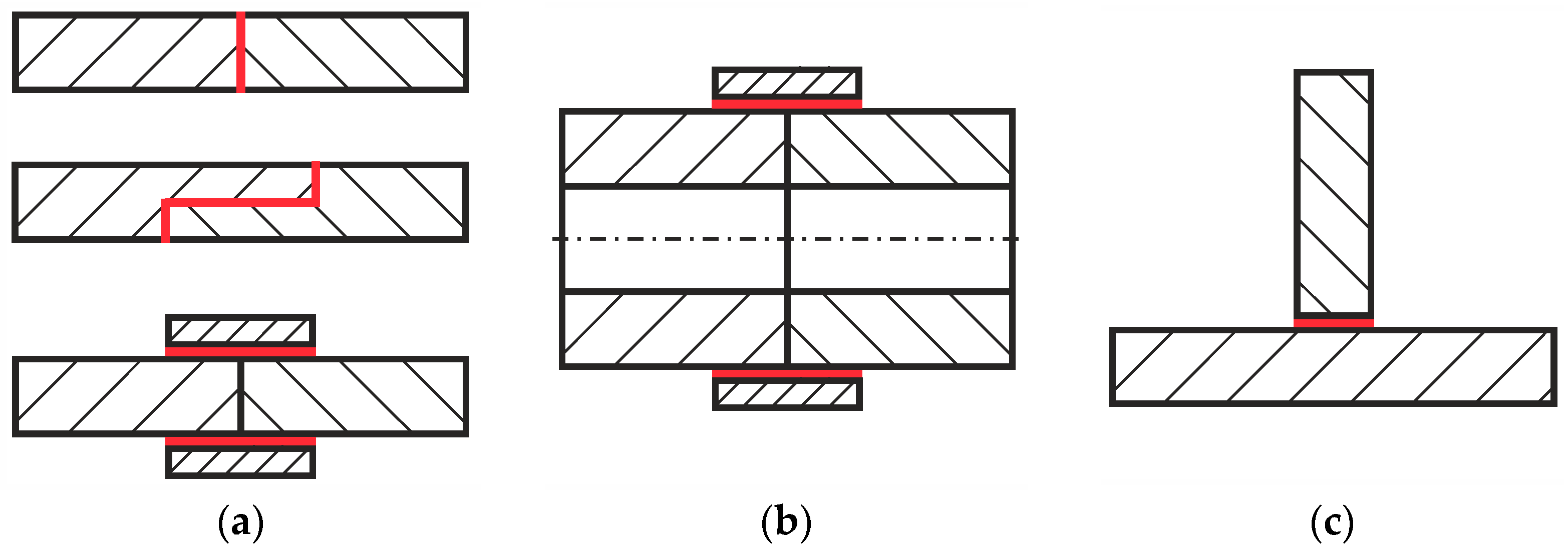
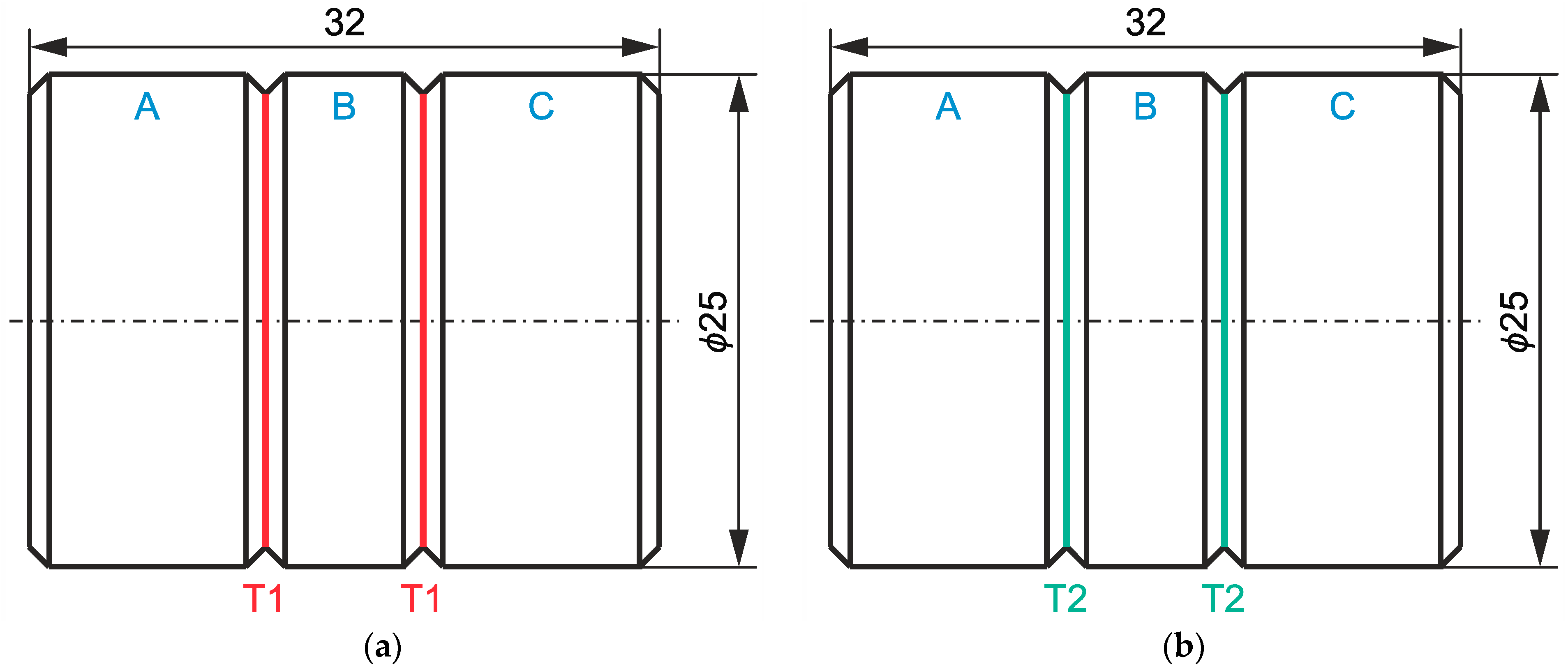
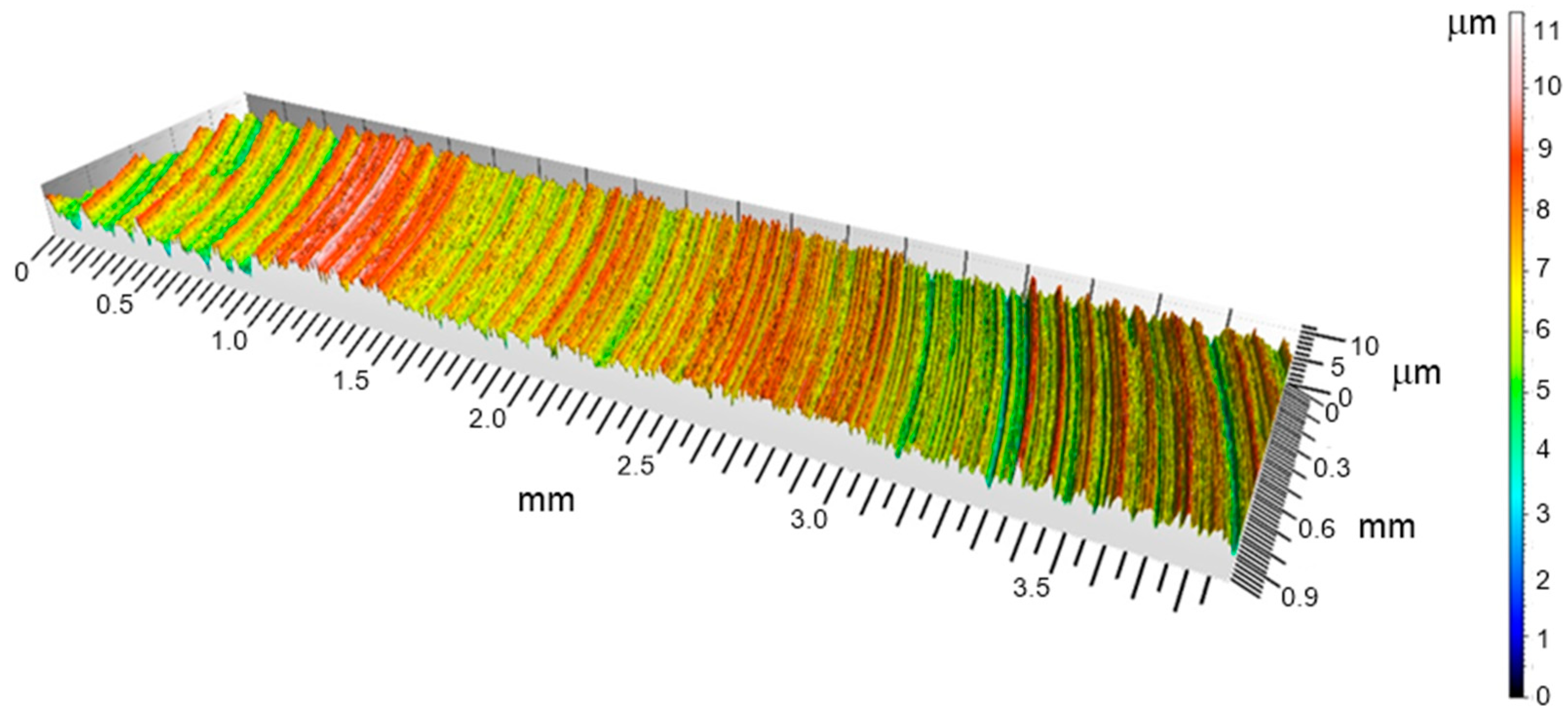


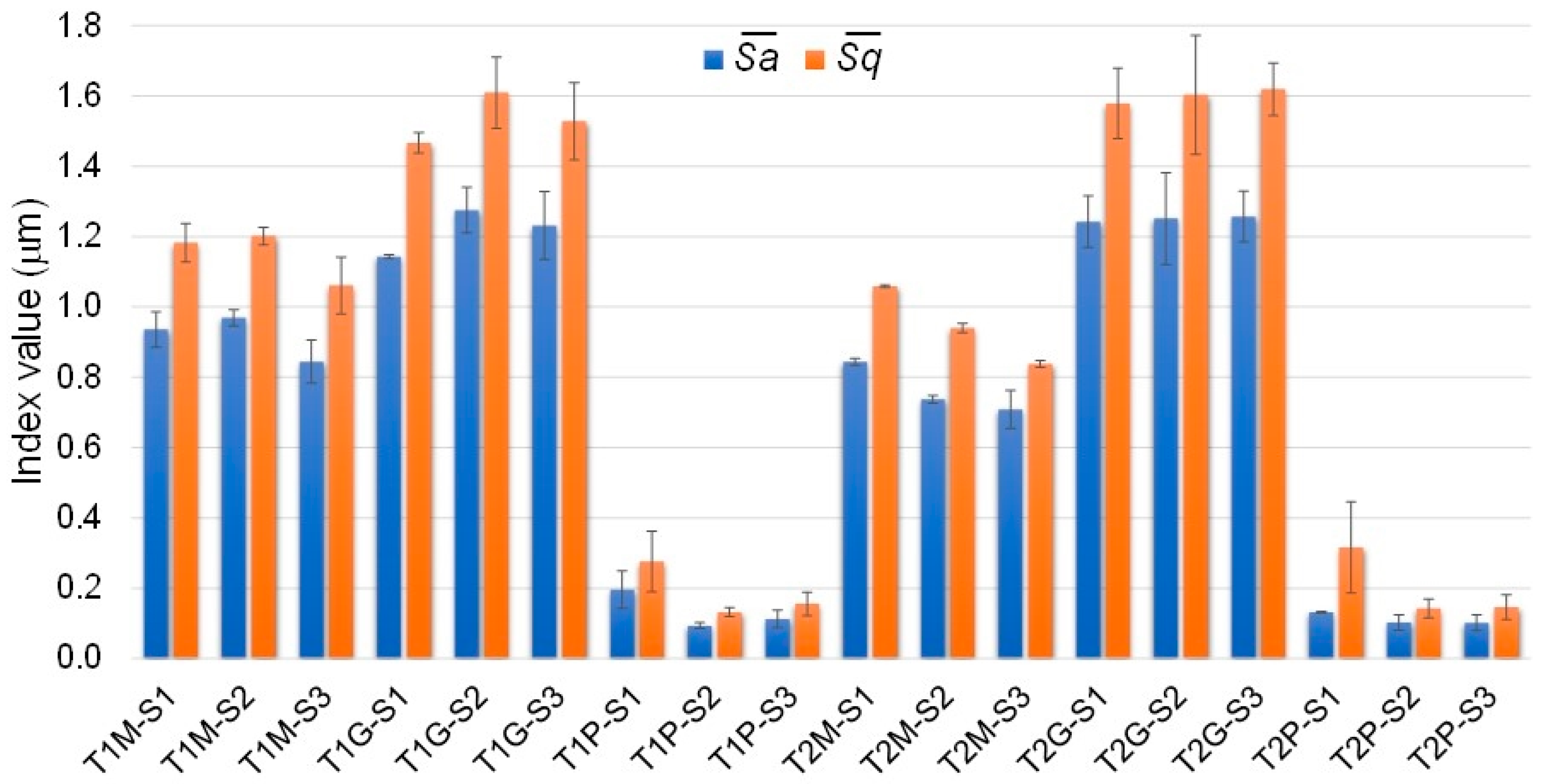
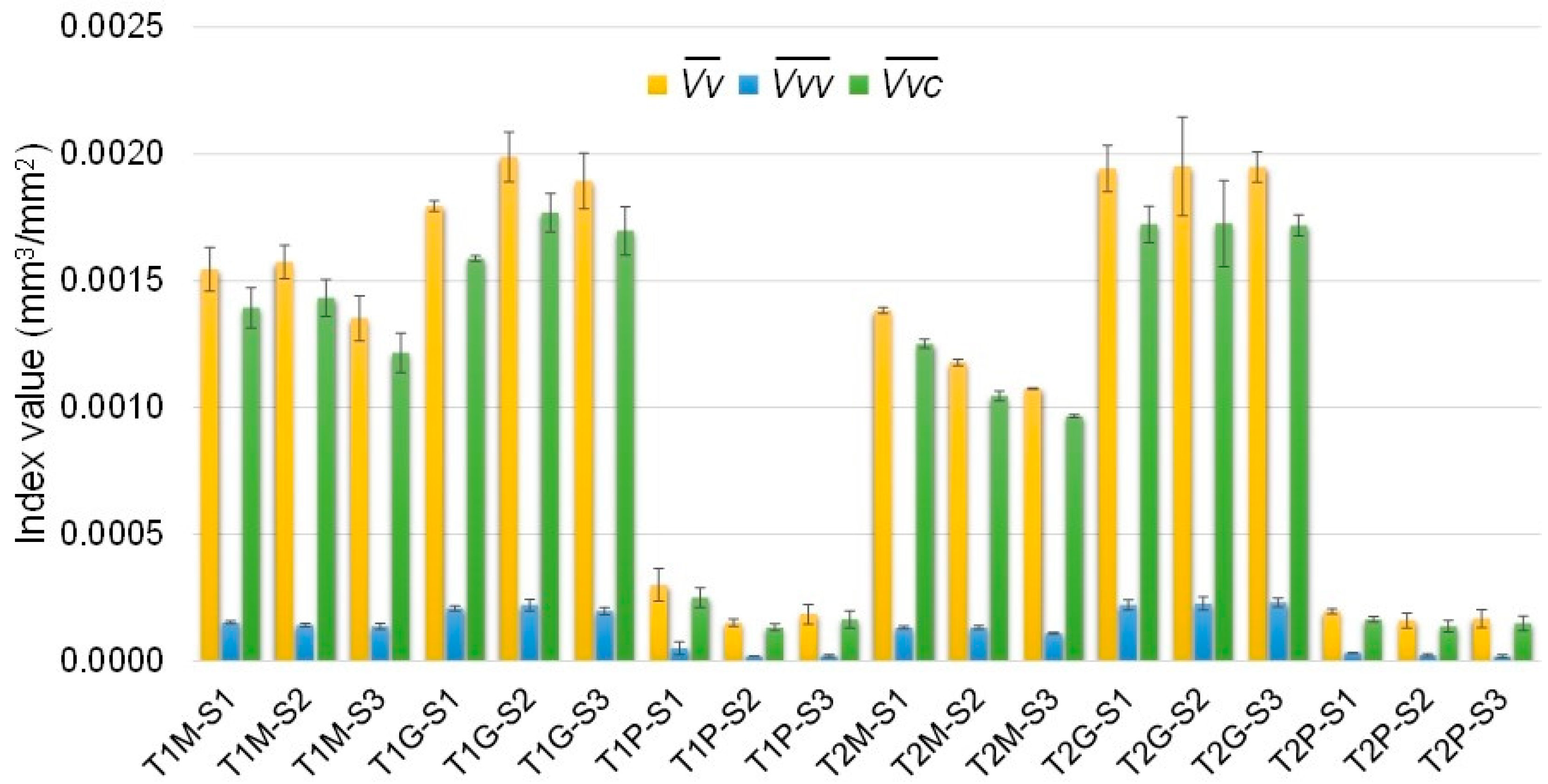

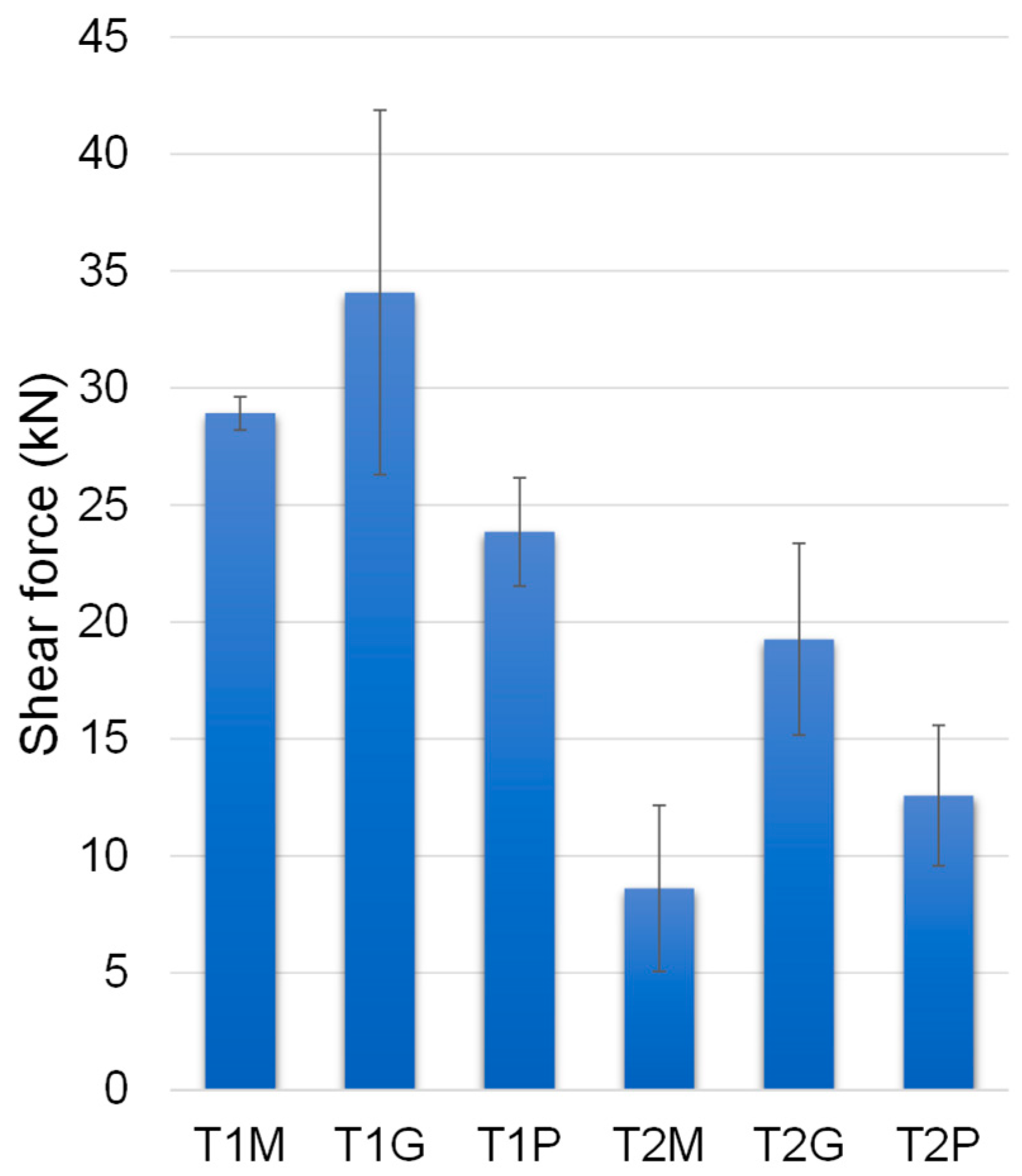
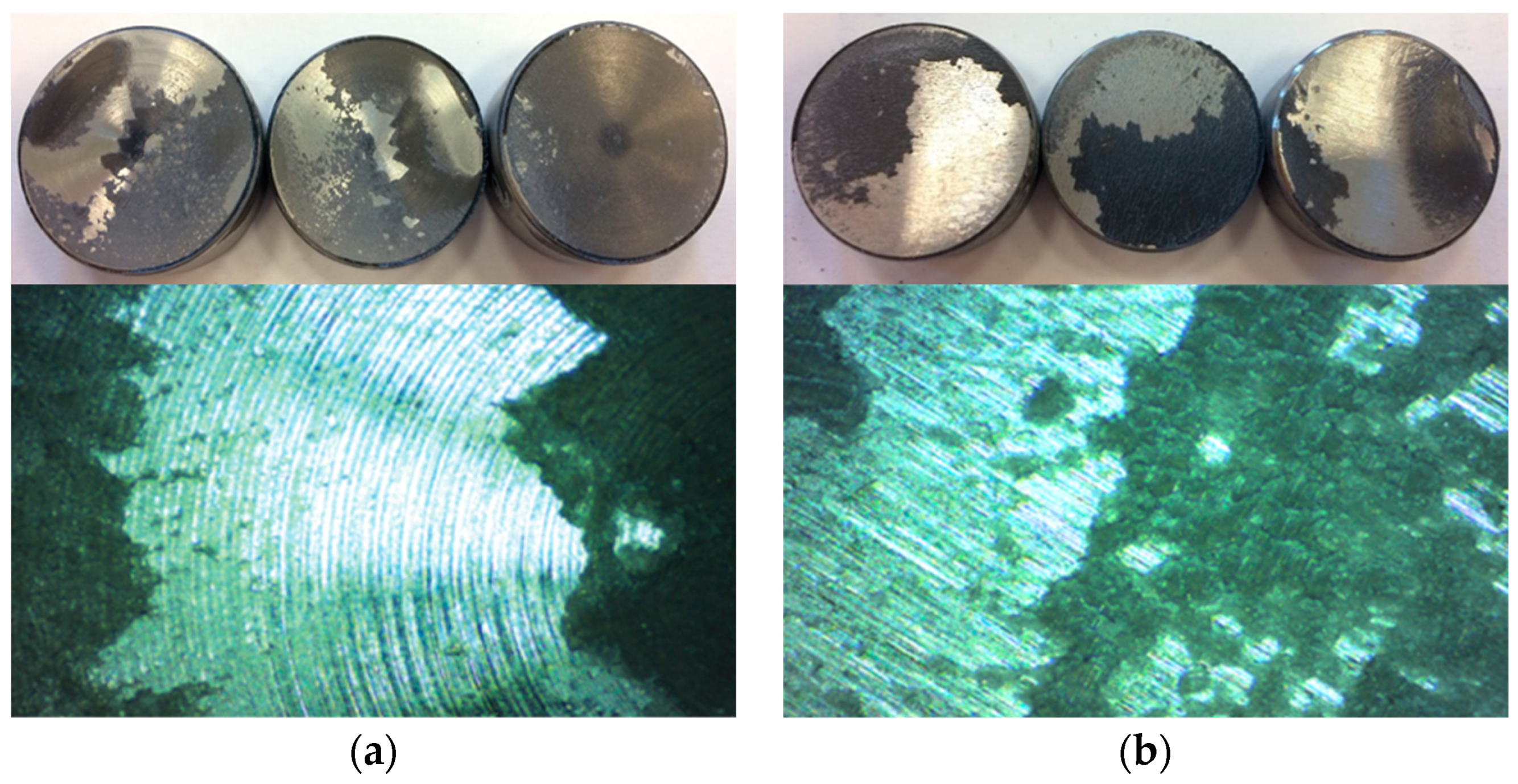
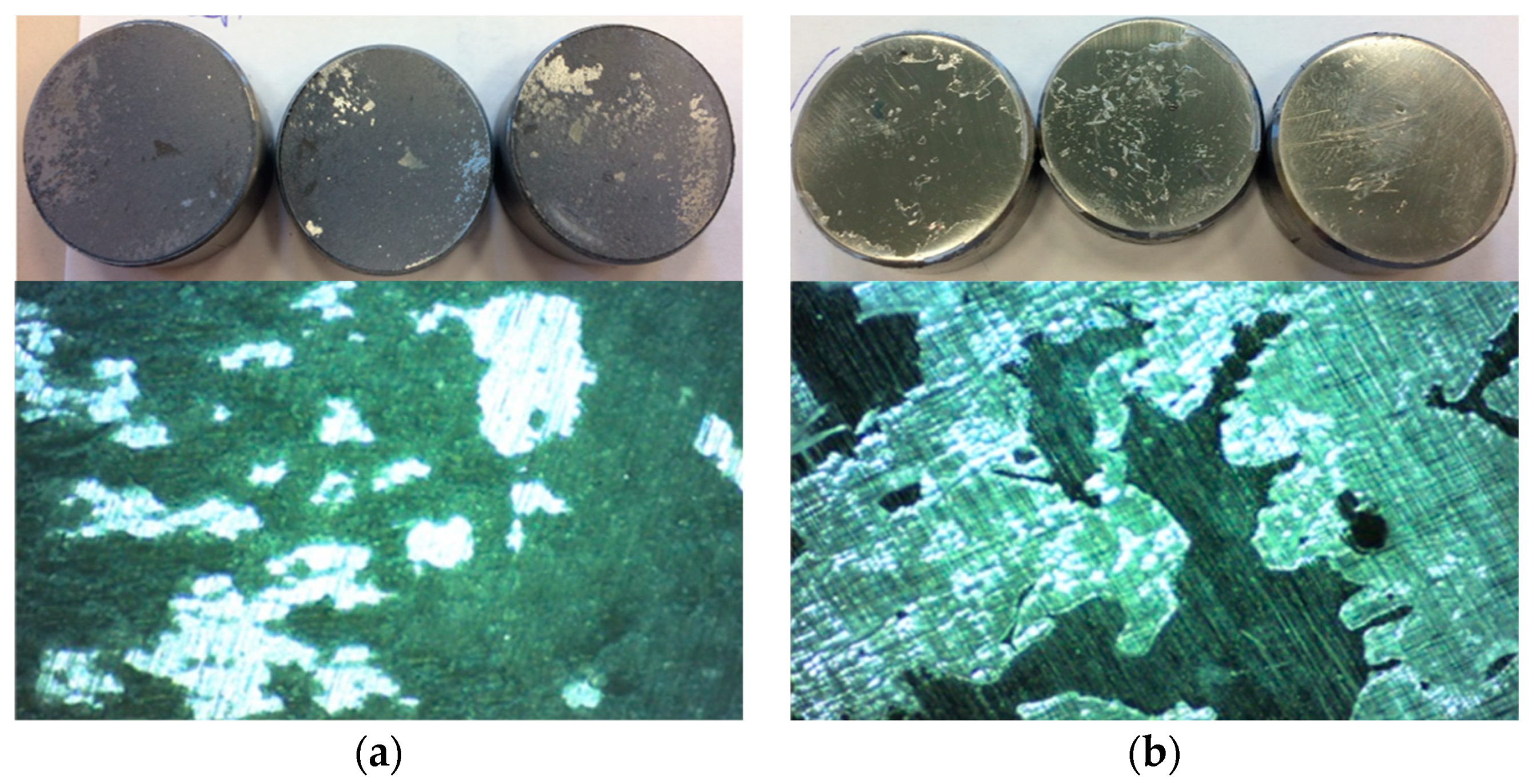

| Properties | Selected Technical Parameters | |
|---|---|---|
| T1 Epoxy Adhesive | T2 Cyanoacrylate Adhesive | |
| Chemical composition | Industrial epoxy adhesive 2:1 (resin + hardener) | Ethyl 2-cyanoacrylate (ECA) |
| Specific gravity at 25 °C | 1.0 | 1.1 |
| Brookfield viscosity at 25 °C (mPa·s) | 25 000 ÷ 60 000 | 30 ÷ 50 |
| Shear strength acc. to ISO 4587 [60] (N/mm2) | 37 | 20 |
| Surface treatment | Marking of Adhesive JJoints | |
|---|---|---|
| T1 Epoxy Adhesive | T2 Cyanoacrylate Adhesive | |
| Milling | T1M-S1 T1M-S2 T1M-S3 | T2M-S1 T2M-S2 T2M-S3 |
| Grinding | T1G-S1 T1G-S2 T1G-S3 | T2G-S1 T2G-S2 T2G-S3 |
| Polishing | T1P-S1 T1P-S2 T1P-S3 | T2P-S1 T2P-S2 T2P-S3 |
| Adhesive Joint Marking | Average Index Value | ||||||||
|---|---|---|---|---|---|---|---|---|---|
(µm) | (µm) | (µm) | (mm3/mm2) | (mm3/mm2) | (mm3/mm2) | (µm) | (no unit) | (no unit) | |
| T1M-S1 | 0.936 | 1.18 | 10.81 | 0.0015 | 0.00015 | 0.00139 | 1.42 | 1.03 | 0.64 |
| T1M-S2 | 0.970 | 1.20 | 9.86 | 0.0016 | 0.00014 | 0.00143 | 1.22 | 1.30 | 0.33 |
| T1M-S3 | 0.844 | 1.06 | 10.24 | 0.0014 | 0.00014 | 0.00122 | 1.23 | 1.21 | 0.39 |
| T1G-S1 | 1.143 | 1.47 | 17.16 | 0.0018 | 0.00021 | 0.00159 | 2.02 | 0.87 | 0.70 |
| T1G-S2 | 1.276 | 1.61 | 16.31 | 0.0020 | 0.00022 | 0.00177 | 2.11 | 0.88 | 0.68 |
| T1G-S3 | 1.232 | 1.53 | 14.76 | 0.0019 | 0.00020 | 0.00170 | 1.82 | 0.92 | 0.64 |
| T1P-S1 | 0.195 | 0.28 | 3.23 | 0.0003 | 0.00005 | 0.00025 | 0.53 | 1.04 | 0.42 |
| T1P-S2 | 0.093 | 0.13 | 2.75 | 0.0002 | 0.00002 | 0.00013 | 0.20 | 1.14 | 0.43 |
| T1P-S3 | 0.112 | 0.16 | 2.57 | 0.0002 | 0.00002 | 0.00016 | 0.21 | 1.29 | 0.37 |
| T2M-S1 | 0.844 | 1.06 | 9.38 | 0.0014 | 0.00013 | 0.00125 | 1.20 | 1.06 | 0.62 |
| T2M-S2 | 0.738 | 0.94 | 8.57 | 0.0012 | 0.00013 | 0.00105 | 1.24 | 0.92 | 0.70 |
| T2M-S3 | 0.709 | 0.84 | 8.51 | 0.0011 | 0.00011 | 0.00097 | 1.03 | 1.01 | 0.65 |
| T2G-S1 | 1.243 | 1.58 | 16.05 | 0.0019 | 0.00022 | 0.00172 | 2.14 | 0.86 | 0.69 |
| T2G-S2 | 1.252 | 1.60 | 17.61 | 0.0020 | 0.00023 | 0.00172 | 2.20 | 0.86 | 0.70 |
| T2G-S3 | 1.258 | 1.62 | 20.81 | 0.0019 | 0.00023 | 0.00172 | 2.21 | 0.82 | 0.70 |
| T2P-S1 | 0.131 | 0.32 | 10.42 | 0.0002 | 0.00003 | 0.00016 | 0.32 | 0.69 | 0.25 |
| T2P-S2 | 0.103 | 0.14 | 2.38 | 0.0002 | 0.00002 | 0.00014 | 0.24 | 1.04 | 0.44 |
| T2P-S3 | 0.101 | 0.15 | 2.63 | 0.0002 | 0.00002 | 0.00015 | 0.19 | 1.08 | 0.61 |
| Adhesive Joint Marking | Shear Force (kN) | Shear Stress (MPa) | Displacement (mm) | Average Failure Pattern |
|---|---|---|---|---|
| T1M-S1 | 29.8 | 35.9 | 0.70 | CF (50%) + SCF (50%) |
| T1M-S2 | 28.6 | 34.4 | 0.40 | |
| T1M-S3 | 28.4 | 34.2 | 0.65 | |
| T1G-S1 | 27.6 | 33.2 | 0.40 | CF (60%) + SCF (40%) |
| T1G-S2 | 31.4 | 37.8 | 0.25 | |
| T1G-S3 | 43.2 | 52.0 | 0.60 | |
| T1P-S1 | 22.7 | 27.3 | 1.23 | CF (20%) + SCF (80%) |
| T1P-S2 | 22.1 | 26.6 | 1.23 | |
| T1P-S3 | 26.8 | 32.3 | 1.38 | |
| T2M-S1 | 13.0 | 15.6 | 1.25 | CF (50%) + SCF (50%) |
| T2M-S2 | 5.90 | 7.10 | 0.85 | |
| T2M-S3 | 7.00 | 8.43 | 1.45 | |
| T2G-S1 | 23.2 | 27.9 | 1.08 | CF (90%) + SCF (10%) |
| T2G-S2 | 15.0 | 18.1 | 1.00 | |
| T2G-S3 | 19.6 | 23.6 | 1.10 | |
| T2P-S1 | 11.8 | 14.2 | 1.50 | CF (70%) + SCF (30%) |
| T2P-S2 | 16.0 | 19.3 | 2.50 | |
| T2P-S3 | 10.0 | 12.0 | 1.35 |
Disclaimer/Publisher’s Note: The statements, opinions and data contained in all publications are solely those of the individual author(s) and contributor(s) and not of MDPI and/or the editor(s). MDPI and/or the editor(s) disclaim responsibility for any injury to people or property resulting from any ideas, methods, instructions or products referred to in the content. |
© 2024 by the authors. Licensee MDPI, Basel, Switzerland. This article is an open access article distributed under the terms and conditions of the Creative Commons Attribution (CC BY) license (https://creativecommons.org/licenses/by/4.0/).
Share and Cite
Sługocka, M.; Grochała, D.; Kwiatkowski, K.; Grzejda, R.; Zmarzły, P. Study of the Impact of Surface Topography on Selected Mechanical Properties of Adhesive Joints. Coatings 2024, 14, 944. https://doi.org/10.3390/coatings14080944
Sługocka M, Grochała D, Kwiatkowski K, Grzejda R, Zmarzły P. Study of the Impact of Surface Topography on Selected Mechanical Properties of Adhesive Joints. Coatings. 2024; 14(8):944. https://doi.org/10.3390/coatings14080944
Chicago/Turabian StyleSługocka, Małgorzata, Daniel Grochała, Konrad Kwiatkowski, Rafał Grzejda, and Paweł Zmarzły. 2024. "Study of the Impact of Surface Topography on Selected Mechanical Properties of Adhesive Joints" Coatings 14, no. 8: 944. https://doi.org/10.3390/coatings14080944
APA StyleSługocka, M., Grochała, D., Kwiatkowski, K., Grzejda, R., & Zmarzły, P. (2024). Study of the Impact of Surface Topography on Selected Mechanical Properties of Adhesive Joints. Coatings, 14(8), 944. https://doi.org/10.3390/coatings14080944








